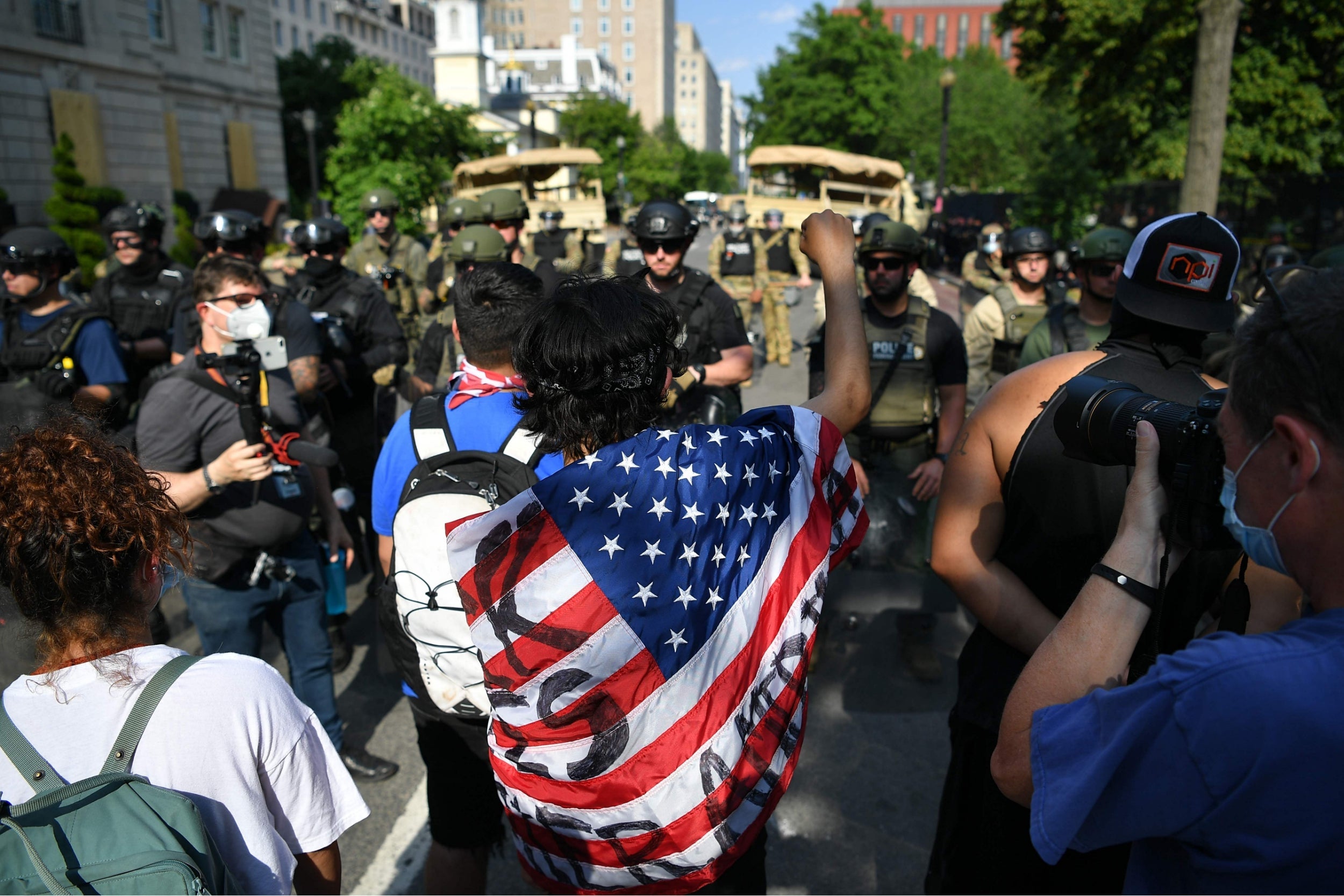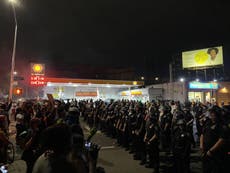Trump has tried to paint the George Floyd protests as orgies of violence. Here’s what they really look like
Take what Tucker Carlson tells you with a huge pinch of salt
The protesters had just crossed Manhattan Bridge from Brooklyn when they came to a stop just a few blocks from Wall Street. An organiser at the front called a halt to the march and took the megaphone.
“It is the 99th anniversary of the burning of Black Wall Street. Three hundred lives were lost,” she shouted at the top of her voice, referring to the 1921 Tulsa race massacre in which white residents killed their black neighbours and burned their businesses to the ground. “Tonight we march for Black Wall Street,” she added.
Not far from where she spoke to the thousand-strong crowd, just off to the side, a group of younger men wearing masks were growing restless. “Come with us if you wanna go looting,” one shouted, struggling to be heard. “Let’s go looting!” he urged again, and again, waiting for a response. None came. He was ignored, and the march continued peacefully.
There were many marches across the city that night, thousands-strong, but the next day it was the young looters, and their fewer numbers, who made the news.
That scene and its aftermath was illustrative of a wider issue with how nationwide protests over the police killing of George Floyd have been portrayed: The vast majority of these demonstrations are peaceful and organised, they are on a scale which has not been seen in America for decades – and yet they have been overshadowed by scenes of chaos and violence caused by a small minority.
Looting and violence has dominated the headlines. At times, with notable exceptions, television coverage of the protests has looked more like the fall of Baghdad than a domestic disturbance. Anchors in studios deliver monologues as they watch helicopter shots of protesters moving through the streets and replay clips of scuffles between police and demonstrators. The voices of protesters are lost.

This sin of omission pales in comparison to the deliberate and calculated strategy of Donald Trump’s administration to seize upon the chaos for political gain. Trump has sought to portray the nationwide unrest as a crisis of law and order, blaming left-wing radicals and agitators. Choosing to focus only on the scenes of violence, he has threatened to deploy the US military to American cities to bring calm.
“If a city or state refuses to take the actions necessary to defend the life and property of their residents, then I will deploy the United States military and quickly solve the problem for them,” he said.
Trump’s characterisation of the protests has been echoed by his supporters in conservative media. In a scathing monologue earlier this week, Fox commentator Tucker Carlson sought to blur the lines between peaceful protesters and the violent minority.
“On television, hour by hour, we watch these people – criminal mobs – destroy what the rest of us have built,” he said. “People like this don’t bother to work. They don’t volunteer or pay taxes to help other people. They live for themselves. They do exactly what they feel like doing. They say exactly what they feel like saying.”
The picture painted by Trump and his allies could not be further from the truth. There have been outbreaks of violence in cities across the US – that much is true. Police have been attacked, property has been damaged and stores have been looted. But it only takes one person to light a fire. It only takes a few dozen people to bring a city to a halt when police are busy breaking up peaceful protests elsewhere.
Here in New York, and across the country, there has been a concerted effort by protesters to ensure their demonstrations remain peaceful. On Monday night, in Brooklyn, I watched as a man interrupted a thoughtful speech by one protester to shout: “Violence is the answer!” In an instant, a young black woman rushed up to him and in no uncertain terms told him to “Shut the f*** up.”
These scenes have been playing out across the country. On Tuesday evening, one video showed a protester grabbing a looter and throwing them to the ground as they left a store in Manhattan, shouting: “You are not a black ally.” A woman in the East Village was filmed screaming at looters as they broke into a store beneath her apartment. Another video, from Raleigh in North Carolina, showed a man smashing a window with his skateboard before he was tackled and moved on.
In fact, much of the violence seen on television screens has been sparked by overzealous law enforcement agencies attempting to break up peaceful protests. The irony is laid bare for the world to see: protests against police brutality have been met with even more police brutality. Amnesty International was prompted to issue a statement slamming the response of US police to the protests.
“US police across the country are failing their obligations under international law to respect and facilitate the right to peaceful protest, exacerbating a tense situation and endangering the lives of protesters,” said Rachel Ward, national director of research at Amnesty International USA.
“In city after city, we are witnessing actions that could be considered unnecessary or excessive force. We call for an immediate end to any such use of force and for law enforcement to ensure and protect the legal right to protest,” she added.
There is a purpose behind Trump’s attempts to cast the protesters as villains. In doing so, he can play the role of a strongman, a bringer of order and stability. Perhaps aware of the fact that he is incapable of addressing the deep structural and systemic problems of racial injustice and police violence in America, he can instead turn to a neater and far more brutal solution. A military solution for a social problem.
That may be harder than he thinks. The initial bursts of violence in cities across the country have ebbed, for now, and given way to still larger marches. With fewer images of anarchy to point to, Trump’s calls for a crackdown will find fewer and fewer sympathetic ears.

And what is left? What has been there all along in the background: Hundreds of thousands of people expressing their anger over Floyd’s death and racial inequality by peacefully protesting. Marches that break off into mass meetings and grieving sessions, poetry readings and vigils, that are multicultural and multigenerational. Young people, many protesting for the first time in their lives, giving and listening to speeches, repeating the names of the black men and women killed by police over and over again and vowing not to forget them.
The mood was summed up better than hours of rolling news coverage ever could by one young protester in Brooklyn, just before she headed home for curfew on Monday evening.
“I feel like I’m alive, more than I have ever felt in my life. And I feel like I have something to fight and to stand for,” the protester, named Haniq, told me. “We’re here for change long-term, so we’re here for the long-term. The fire will keep burning.”



Join our commenting forum
Join thought-provoking conversations, follow other Independent readers and see their replies